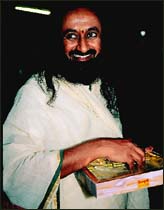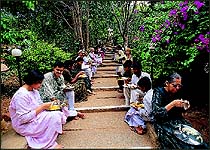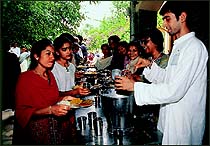


 cover story
cover storyThayir Sadam And Payasam! At the Ved Vignan Maha Vidya Peeth in Bangalore, MARK MANUEL meets spiritual guru SRI SRI RAVI SHANKAR and learns from him the �Art of Eating�. |
|
JAI GURUDEV! I present His Holiness Sri Sri Ravi Shankar, the enlightened Master of the internationally acclaimed Art of Living Foundation. I am told, this Master is like a window, through him one can see the infinite. But I am not looking to see the infinite. I am keen on discovering the foodie in �Guruji�. That�s what his disciples call Sri Sri Ravi Shankar. And it is this inner circle of disciples, the students closest to him, that has led me to believe that Guruji is a great lover of food... if not a complete gourmet. To find out the truth, I must make a pilgrimage to his ashram in Bangalore, the Ved Vignan Maha Vidya Peeth. It is in Udaypura, on Kanakpura Road, 40 km from Bangalore Airport. Guruji, who is otherwise reticent in his ways, and most reluctant to talk to journalists, has actually given me time. �It can be 5 minutes or 45,� I am warned before hand. �And you must agree to do the Art of Living course after that. Guruji does something for you, you must do something for him.� I don�t exactly baulk at the idea, but I demur. �Will Guruji have lunch with me,� I daringly ask the sexy disciple who has worked out my meeting with the Master. She replies coldly: �He�s meeting you after tea!� There must be few people in the world who have not heard of The Art of Living Foundation. It was started by Guruji in 1982 with the sole aim of making life a celebration. Run by liberated volunteers on a no-profit basis as an educational organisation, the Art of Living Foundation has over 2,000 centres in 113 countries. It is accredited as an official non-governmental organisation with the UN. And it offers workshops for spiritual growth and self-development that teach people the art of getting back their original enthusiasm, energy and joy. The programme integrates modern science with ancient wisdom, with emphasis on conscious holistic living and personal self-development, to improve body, mind and spirit. Thousands are supposed to have benefitted by it. Each one of them personally touched by the spirit of child-like simplicity and joy that emanates from Guruji.
But then he has not heard of Udaypura, as well. So I am not unduly perturbed. And we make our way out of the airport and zig-zag through the garden city in an uncertain manner, stopping every now and then to ask directions to Udaypura, myself hanging out of the window looking for billboards that announce the approach of Guruji�s ashram. And round about noon, we arrive there, the car groaning up a steep, curving driveway to come to a halt under swaying palm trees near the entrance to the ashram. There are people everywhere, disciples well advanced in the Art of Living, plus newcomers seeking enlightenment. And though nobody is in costume, meaning they don�t dress like the maroon-robed sanyasins of the Osho Commune in Pune, it is easy to make out who is already Sri Sri Ravi Shankar�s disciple and who is not. The men all try to look like him, with long hair, flowing beards and drooping moustaches. But I am to discover later that they lack his vivacity, the sheer mischief in his eyes, and his powerful, 1,000 watt, enigmatic smile. The women appear to have benefitted more from the Art of Living. There is about them the gay abandon of young children at play school. There is a youthful sense of celebration and joy everywhere. And there is profound silence as well. Of spirituality, there is not a trace that I can see. I don�t know what I expected to find, but the ashram surprises me. Maybe that is what Guruji�s message is all about. I am fortunate, it is lunch time at the ashram by the time I announce myself and establish contact with the disciples who will take me to Guruji. The disciples lead me to the large kitchen on the premises where lunch for upto 8,000 can be cooked at one time. However, that day the ashram is feeding only 200. Make that 202, they are laying out thalis for my editor and photographer Farzana Contractor and me too. The kitchen is like a big community hall, disciples are sitting on the floor engaged in cutting and cleaning vegetables for the meal. And in the cooking area, the presiding deities, chefs Ramesh Hegde and D. Girish, are busy getting Guruji�s lunch ready and lunch for the rest of us 202. I am allowed into the kitchen upto a point, but not where they are cooking Guruji�s food. �Somethings are sacred here,� the disciple who is taking me around says mysteriously. I am told that lunch at the ashram is almost spartan. Rice, dal and a sabzi. However, that afternoon, it is a celebration. Rice and a khichdi, a mixed vegetable, salad, dal, and payasam, thick, sweet with jaggery and coconut milk, and rich with plums and cashewnuts. Messrs. Hegde and Girish are brahmin priests. They have spent between six and 11 years at the ashram with Guruji and admit to having learnt cooking on the job. �Guruji always guided us in the kitchen. �Do this� he would say. Or, �Don�t do that.� And the food would always come out perfect. We have never failed him in our cooking.�
Idli, dosai, upma, these things are common here. He will eat all this as well. But he is especially fond of Thayir Sadam and Payasam. Payasam is a milk-based sweet. We make it of rice, chana dal and semiya. At one time Guruji was a big one for sweets. He liked Puranpoli. Now he doesn�t eat so many sweets. Not as much as before, except for the Payasam. He leaves his menu to us totally. Some years ago he was very demanding. Now only on special occasions like Shivratri does he decide the menus. He sometimes cooks for the entire ashram too on such days.�
|

Home Page
 Bangalore is hot and sticky, I land at the airport around breakfast time with a frightful thud, and then seek an air-conditioned Honda to drive me out of the city and towards Udaypura. Guruji grins down at me from an illuminated neon sign at the airport that welcomes the visitor to Bangalore. I am reassured that he is �big� here. However, my driver has not heard of Sri Sri Ravi Shankar.
Bangalore is hot and sticky, I land at the airport around breakfast time with a frightful thud, and then seek an air-conditioned Honda to drive me out of the city and towards Udaypura. Guruji grins down at me from an illuminated neon sign at the airport that welcomes the visitor to Bangalore. I am reassured that he is �big� here. However, my driver has not heard of Sri Sri Ravi Shankar.
 In between mouthfuls of steaming, sumptuous food, I get the lowdown on Guruji�s eating habits. �He is a curd-rice person,� says Hegde. �Thayir Sadam, that�s what it is called in Tamil. Yes, Guruji must have his Thayir Sadam every day. We don�t use onion and garlic in the food here. It�s not good for the body! This is satvik khana we cook. Only vegetarian food. We make plenty of lentils, assorted salads, the food is often cream-based, Guruji likes it that way. He also likes Bise Bele Hulli Anna, which is a spicy sambar rice, and he likes Pulliodarai, tamarind rice garnished with grated coconut and sesame seeds.
In between mouthfuls of steaming, sumptuous food, I get the lowdown on Guruji�s eating habits. �He is a curd-rice person,� says Hegde. �Thayir Sadam, that�s what it is called in Tamil. Yes, Guruji must have his Thayir Sadam every day. We don�t use onion and garlic in the food here. It�s not good for the body! This is satvik khana we cook. Only vegetarian food. We make plenty of lentils, assorted salads, the food is often cream-based, Guruji likes it that way. He also likes Bise Bele Hulli Anna, which is a spicy sambar rice, and he likes Pulliodarai, tamarind rice garnished with grated coconut and sesame seeds.